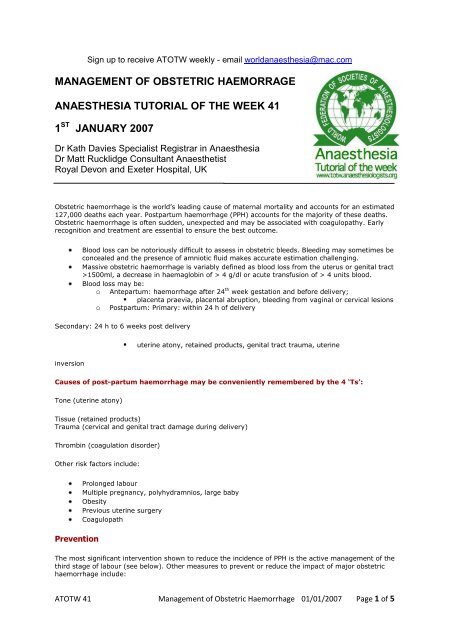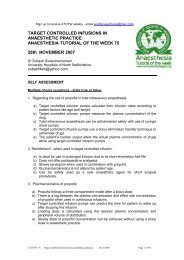BODY FLUIDS - Anaesthesia Tutorial of the Week
BODY FLUIDS - Anaesthesia Tutorial of the Week
BODY FLUIDS - Anaesthesia Tutorial of the Week
Create successful ePaper yourself
Turn your PDF publications into a flip-book with our unique Google optimized e-Paper software.
Sign up to receive ATOTW weekly - email worldanaes<strong>the</strong>sia@mac.com<br />
MANAGEMENT OF OBSTETRIC HAEMORRAGE<br />
ANAESTHESIA TUTORIAL OF THE WEEK 41<br />
1 ST JANUARY 2007<br />
Dr Kath Davies Specialist Registrar in <strong>Anaes<strong>the</strong>sia</strong><br />
Dr Matt Rucklidge Consultant Anaes<strong>the</strong>tist<br />
Royal Devon and Exeter Hospital, UK<br />
Obstetric haemorrhage is <strong>the</strong> world‟s leading cause <strong>of</strong> maternal mortality and accounts for an estimated<br />
127,000 deaths each year. Postpartum haemorrhage (PPH) accounts for <strong>the</strong> majority <strong>of</strong> <strong>the</strong>se deaths.<br />
Obstetric haemorrhage is <strong>of</strong>ten sudden, unexpected and may be associated with coagulopathy. Early<br />
recognition and treatment are essential to ensure <strong>the</strong> best outcome.<br />
Blood loss can be notoriously difficult to assess in obstetric bleeds. Bleeding may sometimes be<br />
concealed and <strong>the</strong> presence <strong>of</strong> amniotic fluid makes accurate estimation challenging.<br />
Massive obstetric haemorrhage is variably defined as blood loss from <strong>the</strong> uterus or genital tract<br />
>1500ml, a decrease in haemaglobin <strong>of</strong> > 4 g/dl or acute transfusion <strong>of</strong> > 4 units blood.<br />
Blood loss may be:<br />
o Antepartum: haemorrhage after 24 th week gestation and before delivery;<br />
placenta praevia, placental abruption, bleeding from vaginal or cervical lesions<br />
o Postpartum: Primary: within 24 h <strong>of</strong> delivery<br />
Secondary: 24 h to 6 weeks post delivery<br />
inversion<br />
uterine atony, retained products, genital tract trauma, uterine<br />
Causes <strong>of</strong> post-partum haemorrhage may be conveniently remembered by <strong>the</strong> 4 ‘Ts’:<br />
Tone (uterine atony)<br />
Tissue (retained products)<br />
Trauma (cervical and genital tract damage during delivery)<br />
Thrombin (coagulation disorder)<br />
O<strong>the</strong>r risk factors include:<br />
Prevention<br />
Prolonged labour<br />
Multiple pregnancy, polyhydramnios, large baby<br />
Obesity<br />
Previous uterine surgery<br />
Coagulopath<br />
The most significant intervention shown to reduce <strong>the</strong> incidence <strong>of</strong> PPH is <strong>the</strong> active management <strong>of</strong> <strong>the</strong><br />
third stage <strong>of</strong> labour (see below). O<strong>the</strong>r measures to prevent or reduce <strong>the</strong> impact <strong>of</strong> major obstetric<br />
haemorrhage include:<br />
ATOTW 41 Management <strong>of</strong> Obstetric Haemorrhage 01/01/2007 Page 1 <strong>of</strong> 5
Sign up to receive ATOTW weekly - email worldanaes<strong>the</strong>sia@mac.com<br />
· Avoidance <strong>of</strong> prolonged labour<br />
· Minimal trauma during assisted vaginal delivery<br />
· Detection and treatment <strong>of</strong> anaemia during pregnancy<br />
· Identification <strong>of</strong> placenta praevia by ant-natal ultrasound examination<br />
Active Management <strong>of</strong> <strong>the</strong> Third Stage<br />
This represents a group <strong>of</strong> interventions including controlled cord traction for placenta delivery and<br />
prophylactic administration <strong>of</strong> a uterotonic at delivery (e.g. Syntometrine®). Active management <strong>of</strong> <strong>the</strong><br />
third stage is associated with a lower incidence <strong>of</strong> PPH and need for blood transfusion.<br />
Placental Abruption<br />
The premature separation <strong>of</strong> a normally sited placenta from <strong>the</strong> uterine wall after <strong>the</strong> 20 th week <strong>of</strong><br />
gestation and prior to delivery. It is a cause <strong>of</strong> antepartum haemorrhage and associated with a<br />
significant risk to both mo<strong>the</strong>r and fetus.<br />
Risk factors:<br />
Previous history <strong>of</strong> abruption<br />
Maternal hypertension<br />
Smoking<br />
History <strong>of</strong> premature rupture <strong>of</strong> membranes<br />
Abdominal trauma<br />
Post-amniocentesis<br />
High parity<br />
Cocaine use<br />
Signs and symptoms include:<br />
Vaginal bleeding. Beware, bleeding may be concealed in up to 30% <strong>of</strong> cases<br />
Lower abdominal tenderness<br />
Rapid abnormal uterine contractions<br />
Fetal heart rate abnormalities<br />
Premature labour<br />
Intrauterine death<br />
Maternal cardiovascular collapse<br />
Disseminated intravascular coagulation (DIC)<br />
Massive obstetric haemorrhage<br />
· Diagnosis <strong>of</strong> placental abruption is essentially clinical and must be considered without<br />
delay if any suggestive signs and symptoms are present.<br />
· Treatment includes resuscitation with oxygen and intravenous fluids.<br />
Immediate obstetric and neonatal support<br />
Urgent delivery if fetal distress. Caesarean section unless imminent vaginal delivery.<br />
Management <strong>of</strong> shock (see below) and coagulopathy should it develop.<br />
General anaes<strong>the</strong>sia is <strong>of</strong>ten <strong>the</strong> preferred technique due to <strong>the</strong> risk <strong>of</strong> hypovolaemia and<br />
coagulopathy and severe fetal distress. If regional anaes<strong>the</strong>sia is considered, <strong>the</strong> coagulation<br />
pr<strong>of</strong>ile <strong>of</strong> <strong>the</strong> woman must be checked.<br />
ATOTW 41 Management <strong>of</strong> Obstetric Haemorrhage 01/01/2007 Page 2 <strong>of</strong> 5
Sign up to receive ATOTW weekly - email worldanaes<strong>the</strong>sia@mac.com<br />
Placenta Praevia<br />
Encroachment <strong>of</strong> <strong>the</strong> placenta upon <strong>the</strong> cervical os.<br />
· Grade 1: low-lying placenta (in lower uterine segment) that does not reach <strong>the</strong> os<br />
· Grade 2: Placenta reaches <strong>the</strong> os<br />
· Grade 3: Placenta covers os but is positioned to one side<br />
· Grade 4: Placenta is positioned squarely over <strong>the</strong> os<br />
Risk Factors<br />
· Previous caesarean section<br />
· Multiple pregnancy<br />
· Multiparity<br />
· Previous myomectomy<br />
Major Obstetric Haemorrhage Management<br />
Pregnant women are <strong>of</strong>ten young, healthy and have an increased blood volume <strong>of</strong> up to 20% at term<br />
and are <strong>the</strong>refore likely to compensate well to haemorrhage until <strong>the</strong> circulating blood volume is very<br />
low. In addition, blood loss may sometimes be concealed and difficult to calculate.<br />
More commonly massive haemorrhage may be obvious; signs o<strong>the</strong>r than revealed haemorrhage include:<br />
Tachycardia<br />
Hypotension (beware, BP <strong>of</strong> healthy women may not drop until significant blood has been lost)<br />
Pallor<br />
Oliguria<br />
Cool peripheries<br />
Lower abdominal pain<br />
Management <strong>of</strong> <strong>the</strong> Anticipated Major Haemorrhage<br />
On some occasions, cases at high risk <strong>of</strong> massive obstetric haemorrhage can be predicted; e.g.<br />
caesarean section in a lady with a low lying anterior placenta and previous uterine scar. These cases<br />
may be at risk <strong>of</strong> placenta accreta and massive blood loss.<br />
2 large bore IV cannulae<br />
Rapid infusion device or pressure bags in <strong>the</strong>atre<br />
Blood warmer and warming blanket<br />
Blood cross-matched and available<br />
Consider preoperative invasive monitoring<br />
Consider cell salvage if available (see below)<br />
Consider interventional radiological procedures if available (see below)<br />
ATOTW 41 Management <strong>of</strong> Obstetric Haemorrhage 01/01/2007 Page 3 <strong>of</strong> 5
Sign up to receive ATOTW weekly - email worldanaes<strong>the</strong>sia@mac.com<br />
Communication and teamwork are essential in cases <strong>of</strong> both anticipated and unanticipated maternal<br />
haemorrhage:<br />
Call for help. Alert senior obstetrician and anaes<strong>the</strong>tist<br />
Alert blood transfusion service and haematologist<br />
Alert portering service for transport <strong>of</strong> blood samples and collection <strong>of</strong> blood products<br />
Check blood is available. In <strong>the</strong> UK 2-4 units <strong>of</strong> O-negative blood is kept on labour ward for<br />
emergency use<br />
Allocate roles to team members<br />
Ensure departmental guidelines exist for <strong>the</strong> management <strong>of</strong> massive obstetric haemorrhage<br />
and regularly practice „fire drills‟<br />
Goals <strong>of</strong> management<br />
Early identification <strong>of</strong> maternal bleed and institution <strong>of</strong> major haemorrhage drill<br />
Rapid access to circulation and infusion <strong>of</strong> fluid in first instance with rapid availability and<br />
administration <strong>of</strong> blood<br />
Avoidance/limitation <strong>of</strong> complications <strong>of</strong> massive blood transfusion namely: acid/base<br />
disturbance, transfusion related acute lung injury (TRALI), hypocalcaemia, hyperkalaemia,<br />
hypo<strong>the</strong>rmia and thrombocytopaenia<br />
Efficient team working and management decision making<br />
Resuscitation and immediate management<br />
ABC, 100% oxygen<br />
2 large bore cannulae and bloods for X-match<br />
Fluid resuscitation; crystalloid / colloid 2000mls via rapid infuser or pressure bags e.g. Level 1<br />
Rapid Infuser (can achieve > 500ml/min warmed fluid flow)<br />
Transfuse blood ideally through fluid warming device. Give group specific blood if cross-matched<br />
blood not yet available. O-negative blood if available and life threatening bleed<br />
Transfer to <strong>the</strong>atre<br />
Non-surgical intervention for uterine atony:<br />
“Rub up” <strong>the</strong> uterus<br />
Syntometrine (syntocinon 5 units with ergometrine 500 mcg im)<br />
Syntocinon 5 units repeated once if necessary<br />
Followed by 30units/500mls infusion 125ml/h<br />
Ergometrine: 0.5mg im. Give iv if bleeding continues and remains hypovolaemic. May cause<br />
hypertension and is relatively contraindicated in hypertensive conditions <strong>of</strong> pregnancy. High risk <strong>of</strong><br />
vomiting.<br />
Carboprost (Hemabate or prostaglandin F2a)<br />
For uterine atony unresponsive to ergometrine or Syntocinon. Give 250mcg IM (not iv). May cause<br />
bronchospasm, flushing and hypertension.<br />
Misoprostal 100mcg pr<br />
ATOTW 41 Management <strong>of</strong> Obstetric Haemorrhage 01/01/2007 Page 4 <strong>of</strong> 5
Sign up to receive ATOTW weekly - email worldanaes<strong>the</strong>sia@mac.com<br />
Surgical treatment and o<strong>the</strong>r interventions:<br />
Delivery for placental and uterine pathology<br />
B-Lynch suture (brace suture)<br />
Uterine tamponade e.g. Rusch urological balloon or Sengstaken-Blakemore tube<br />
Surgical ligation <strong>of</strong> uterine and internal iliac arteries<br />
Hysterectomy<br />
Compression/clamping aorta to buy time<br />
Uterine replacement if uterine inversion<br />
Radiological arterial embolisation or balloon occlusion (see below)<br />
Anaes<strong>the</strong>tic management<br />
General anaes<strong>the</strong>tic with rapid sequence induction is generally advocated if actively bleeding or<br />
coagulopathic. Reduce dose <strong>of</strong> induction agent if severe on-going bleeding<br />
Regional anaes<strong>the</strong>sia is relative contraindication but may be maintained if patient has an<br />
epidural in situ and bleeding is controlled<br />
Consider arterial line, central venous ca<strong>the</strong>ter and urinary ca<strong>the</strong>ter but only after definitive<br />
treatment has commenced. Their insertion must not delay resuscitation and fluid management<br />
Use fluid warmer and aim to keep patient normo<strong>the</strong>rmic<br />
Regular monitoring <strong>of</strong> haemaglobin level and coagulation using near patient devices if available<br />
(e.g. HemoCue). Fresh frozen plasma, platelet transfusion and cryoprecipitate may be necessary<br />
if coagulopathy develops. Liaise early with <strong>the</strong> haematology department for optimal and timely<br />
product replacement.<br />
Consider systemic haemostatic agents<br />
o Aprotinin (Trasylol®)<br />
o Vitamin K<br />
o Tranexamic acid<br />
o Recombinant Factor VIIa (NovoSeven®)<br />
Postoperative management<br />
Transfer to a high dependency unit or intensive care facility<br />
Anticipate coagulopathy and treat clinically until coagulation results available<br />
Interventional Radiological Techniques<br />
Interventional techniques are gaining in popularity if <strong>the</strong> facilities and expertise exist and are especially<br />
useful for <strong>the</strong> anticipated massive bleed e.g. caesarean section in a woman with anticipated placenta<br />
accreta. Though evidence <strong>of</strong> effectiveness is still limited, <strong>the</strong>re are increasing case reports <strong>of</strong> its<br />
successful use.<br />
Bilateral iliac artery balloons may be placed electively and inflated at caesarean section or<br />
should bleeding occur<br />
Selective uterine artery embolisation can be performed<br />
Complications appear rare and include: haematoma, false aneurysms and lower limb ischaemia<br />
Intra-operative Cell Salvage<br />
Cell salvage has now been used in hundreds <strong>of</strong> cases <strong>of</strong> obstetric bleeds and appears safe. Concerns<br />
relate to re-infusion <strong>of</strong> fetal cells which could <strong>the</strong>oretically cause haemolytic disease in future<br />
pregnancies and also <strong>the</strong> potential for amniotic fluid embolus. If cell salvage techniques are used,<br />
separate suction <strong>of</strong> amniotic fluid is recommended and a leukocyte depletion filter used during reinfusion<br />
<strong>of</strong> salvaged blood. Setting up cell salvage measures should not divert staff and attention from<br />
initial resuscitation.<br />
ATOTW 41 Management <strong>of</strong> Obstetric Haemorrhage 01/01/2007 Page 5 <strong>of</strong> 5




